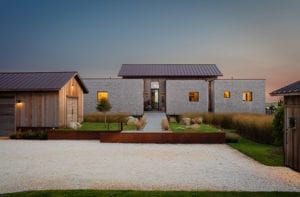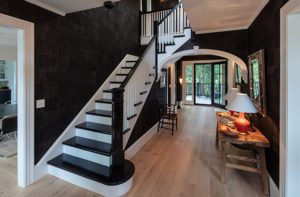5 Reasons to Choose PVC Over Wood for Custom Exterior Millwork
December 4, 2019
Sponsored Content
Text by Kristin Amico
 For some, a drive up the coast from Boston to Portland offers stunning views of rocky Atlantic cliffs, ocean vistas, and fiery fall foliage in autumn. For others, like Josh Cilley, the historic architecture along quiet New England roads is the main attraction. Here, he helps clients, including those building new homes and others restoring classic Colonials or vibrant Victorians, put on the finishing touches with custom exterior millwork made of PVC materials.
For some, a drive up the coast from Boston to Portland offers stunning views of rocky Atlantic cliffs, ocean vistas, and fiery fall foliage in autumn. For others, like Josh Cilley, the historic architecture along quiet New England roads is the main attraction. Here, he helps clients, including those building new homes and others restoring classic Colonials or vibrant Victorians, put on the finishing touches with custom exterior millwork made of PVC materials.
Cilley, owner of Whitewood Millwork, has specialized in millwork fabrication for more than 15 years. He started honing his craft using traditional wood, but as modern products that closely mimic the look and feel of wood became more widely available, he transitioned his business to focus on high-performance, custom PVC millwork.
“We strive to preserve the style and high level of craftsmanship found in traditional New England architecture, but chose to do so with modern materials instead of wood because they last much longer,” Cilley notes.
We talked to him in depth about why he’s a convert and why homeowners should avoid wood in favor of durable PVC for a home’s exterior railings, pergolas, brackets, moldings, or other exterior trim applications.
 Longevity
Longevity
“I loved working with wood, but it’s extremely problematic for exterior surfaces, especially in coastal New England,” Cilley says. He explains that while 100 years ago homes were built with more durable, old-growth forest lumber that could withstand 200 years of hot, humid summers and snowy winters, today’s stock of wood just doesn’t last as long.
Instead, PVC “lumber” is a lifetime investment that will likely outlast the rest of the house, as it won’t split, crack, or rot like traditional wood. While pricier woods such as cedar or mahogany may be less likely to succumb to rot, they will still split and crack when exposed to the extreme temperatures of New England. The other upside to using PVC materials is that it’s insect resistant, and you’ll never have to deal with termite infestations, at least in your custom exterior millwork.
Maintenance
“For a homeowner, one of the most appealing things about PVC is that maintenance costs and effort are near zero,” Cilley says.
Unlike traditional exterior millwork, which needs to be painted or repaired, every five to seven years on average, PVC millwork needs almost no attention after the initial installation and painting.
While the base materials are impervious to water damage, cracking, and splitting, that’s also true of the paint applied to the PVC. “The initial application of paint takes several days to dry, but after it’s fully cured, it won’t peel or crack the way it does on wooden surfaces, meaning you only need to repaint if you want to alter the color.”
Versatility
“We can create the same intricate designs with PVC trim as we can using wood,” says Cilley. In fact, he uses the same tools as he did for wood and can fashion delicate lattice work or decorative banisters for even the most complex custom jobs. The manmade materials allow for more creativity with shapes and surfaces, too. Typically, Cilley wouldn’t recommend large, flat surfaces for exterior decoration when using wood because water will pool and destroy it much more quickly. With PVC, he can work with homeowners to focus on design and form without worrying about issues like rot that plague wood millwork.
And because the PVC comes in wide-format sheets, large parts are able to be cut in a way that isn’t possible with wood. “We’ve been able to make post wraps, wall panels, and even exterior kitchen cabinets without the need for traditional joinery,” says Cilley.
Cost
It’s not cheaper than high-quality woodwork, but it’s more cost effective. That’s because while the price is on par with the highest quality woods like mahogany or cedar, the PVC millwork doesn’t need regular maintenance or painting.
“Think of PVC as an upfront investment that will pay for itself over time,” adds Cilley.
Less Waste
While not top of mind for all consumers, PVC is easier to work with than traditional wood and produces less waste. There is no structural issues such as irregular grain or knots, ensuring each piece is consistent so millworkers can use the entire piece of lumber instead of cutting around natural wood deformities. In addition, Cilley can recycle bits and pieces to form custom shapes because, unlike wood, there is no grain direction or danger of cracking along the seams of the final product.
“Really,” he says, “opting for PVC over wood lets homeowners have more freedom over the overall design and aesthetic of the custom exterior millwork, while making a smart investment that will last the life of the home.”
Whitewood Millwork, Dover, New Hampshire, 603-740-0384
Share
![NEH-Logo_Black[1] NEH-Logo_Black[1]](https://www.nehomemag.com/wp-content/uploads/2022/08/NEH-Logo_Black1-300x162.jpg)
















You must be logged in to post a comment.